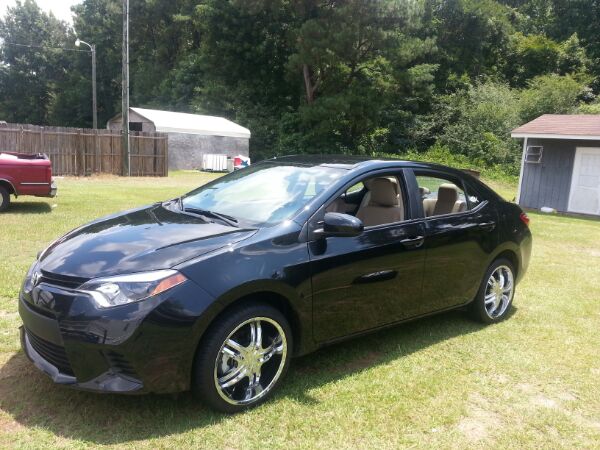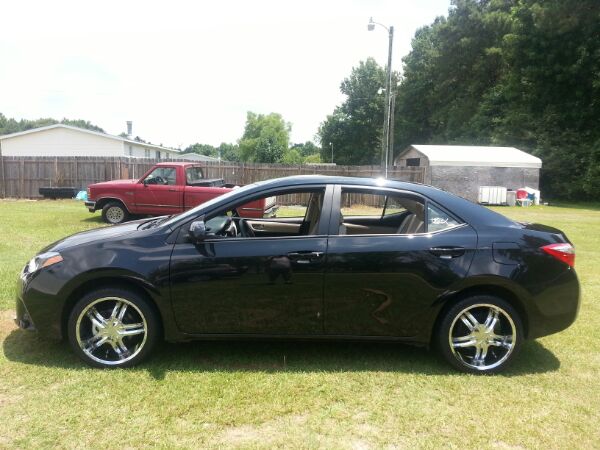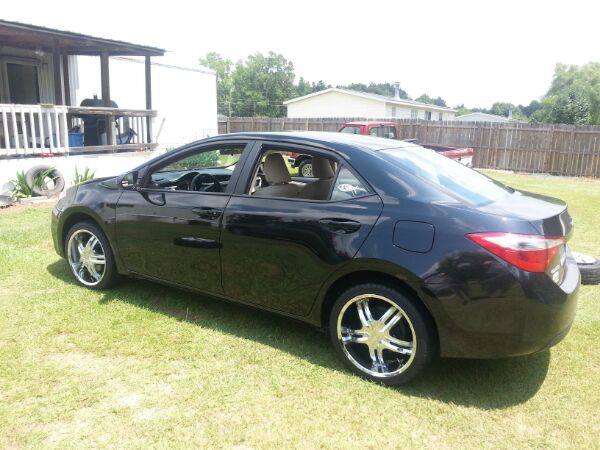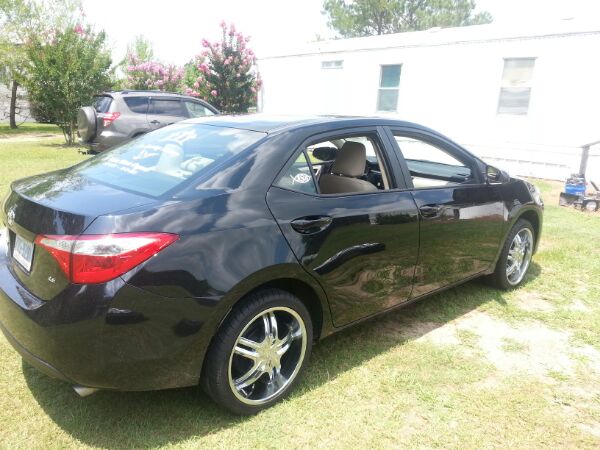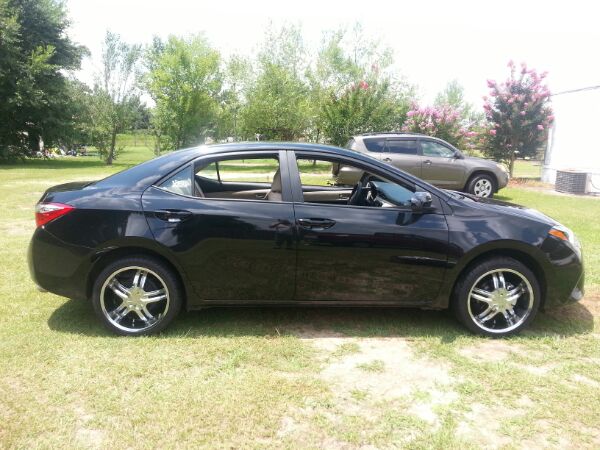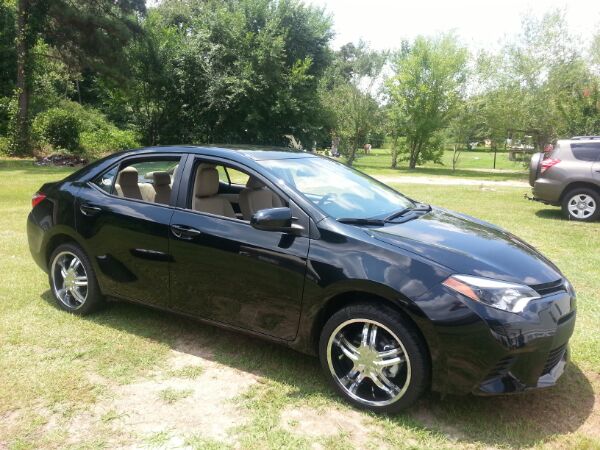Upgrades for My LE
- Thread starter newcorollaowner
- Start date
Nice, if you add some 10th gen Eibach lowering springs it will look on point!
I thought making the car breath better and flow better would with fuel economy.
I don't have time at the moment to elaborate. I'll be back later.:thumbsup:
Made sense with carburetors - more air into the engine gave you better fuel atomization and more power and better mileage.
With fuel injection - the ECU mixes the proper amount of fuel for the amount of air available.
In theory - more air equals more fuel to keep the mixture constant = worse fuel economy. In reality, I don't think the engine actually draws more air through the valves, so it doesn't HURT fuel economy, but it doesn't help either.
Same thing with a dirty air filter - it used to hurt fuel economy - now the engine sees less air from the restricted filter so it mixes less fuel and makes less power, but fuel economy probably increases marginally.
One of the reasons they have gotten to 30K filter intervals ...
http://www.corollaforum.com/showthread.php?p=11810#post11810
With fuel injection - the ECU mixes the proper amount of fuel for the amount of air available.
In theory - more air equals more fuel to keep the mixture constant = worse fuel economy. In reality, I don't think the engine actually draws more air through the valves, so it doesn't HURT fuel economy, but it doesn't help either.
Same thing with a dirty air filter - it used to hurt fuel economy - now the engine sees less air from the restricted filter so it mixes less fuel and makes less power, but fuel economy probably increases marginally.
One of the reasons they have gotten to 30K filter intervals ...
http://www.corollaforum.com/showthread.php?p=11810#post11810
It is maximized for that right from Toyota. A four-cylinder engine only needs so much air and will only generate so much exhaust. Overis the exhaustoing it in those area's will reduce torque and thus fuel economy.
I don't have time at the moment to elaborate. I'll be back later.:thumbsup:
I don't have time at the moment to elaborate. I'll be back later.:thumbsup:
Well I know all car manufacturers put the cheapest parts on there cars and I know the corolla isn't a high dollar car so I know there air filter is restrictive as is the exhaust Toyota won't make money if the put the best parts on a small cheaper fuel economy car like the corolla.
A true cold air intakes provide more power for 2 reasons, the first is that cold air is denser allowing more molecules per square foot which equates to more power and the second reason is that they have worse filters than OEM which allows better air flow. Heat increases fuel economy, in hot air the fuel will vaporize easier, faster and more completely causing a cleaner, more efficient engine. That is why engine manufacturers have increased engine temperatures from ~170-190 to ~215-225 on modern engines. This means that running cooler air into your cylinder head (through your intake) will cause a fuel economy decrease.
A better exhaust will only help if it can flow better than a stock exhaust system. I'm sure that Toyota designed our exhaust system to be able to release more exhaust than can be ingested through our intake filter. This would create a different noise but not much else unless you upgrade the intake system which will, most likely, be detrimental to fuel economy.
TL;DR: The EPA is highly regulatory nowadays, like it or not. Manufacturers cannot create cars without spending millions of dollars in R&D to make the engines as efficient as possible.
So y'all are saying a stock paper filter that has to be replaced every few thousand miles is going to flow better and filter better than a synthetic material filter that washable and reusable? Same thing with the exhaust I don't see Toyota putting any of the racing parts on there street cars which would be the best products. If y'all have prove that the stock air intake and exhaust helps with horsepower and mileage over cold air intakes and exhaust then post it.
So y'all are saying a stock paper filter that has to be replaced every few thousand miles is going to flow better and filter better than a synthetic material filter that washable and reusable? Same thing with the exhaust I don't see Toyota putting any of the racing parts on there street cars which would be the best products. If y'all have prove that the stock air intake and exhaust helps with horsepower and mileage over cold air intakes and exhaust then post it.
Do your own research. We told you the way things work. Im not going to spend lots of time trying to find some guy on youtube try to explain exactly what I just explained.
Race cars are NOT the same as our cars. They run filters like those oiled filters because they do not care if they get crap in their engine if it means they win a race.
By all means, spend a grand or so on these "upgrades" and then come back and tell us how great your fuel economy is.
Read what I said again. I clearly stated that the cold air intake will flow better because it filters less. Take your air filter out, it will flow better. Same deal.
Do your own research. We told you the way things work. Im not going to spend lots of time trying to find some guy on youtube try to explain exactly what I just explained.
Race cars are NOT the same as our cars. They run filters like those oiled filters because they do not care if they get crap in their engine if it means they win a race.
By all means, spend a grand or so on these "upgrades" and then come back and tell us how great your fuel economy is.
Do your own research. We told you the way things work. Im not going to spend lots of time trying to find some guy on youtube try to explain exactly what I just explained.
Race cars are NOT the same as our cars. They run filters like those oiled filters because they do not care if they get crap in their engine if it means they win a race.
By all means, spend a grand or so on these "upgrades" and then come back and tell us how great your fuel economy is.
The PCM will compensate for the amount of air that goes through by controlling how long the injectors stay open for. If you have less restrictive airflow, it improves power, but at the cost of mileage. The mileage really only suffers under wide open throttle though. At cruising speeds, it won't impact your mileage because the engine doesn't need that much air, so it doesn't make a difference if you have a paper filter, a K&N, or no filter. I had a K&N filter, and oiling them is a pain in the ass and the car has to stay parked while the oil dries or you'll foul the spark plugs, so I just stick with FRAM paper filters.
As far as exhaust goes, a bigger pipe give you more top end power but your bottom end suffers, and this will affect your mileage during cruising speeds. A smaller pipe gives you more bottom end power, better mileage, but you sacrifice top end power. It has to do with backpressure. Backpressure helps the combustion chamber scavenge exhaust gases out during the exhaust stroke, so you want some backpressure. You wouldn't want a completely free flowing exhaust.
As far as exhaust goes, a bigger pipe give you more top end power but your bottom end suffers, and this will affect your mileage during cruising speeds. A smaller pipe gives you more bottom end power, better mileage, but you sacrifice top end power. It has to do with backpressure. Backpressure helps the combustion chamber scavenge exhaust gases out during the exhaust stroke, so you want some backpressure. You wouldn't want a completely free flowing exhaust.
The volume of air and how fast it is traveling provides for good fuel economy.
Imagine yourself blowing through a typical soda straw. You'll be able to have that air traveling at high rate of speed.
Now imagine yourself trying to blow through a 5" pipe. Oh yes, the 5" pipe can flow more air, but the velocity of that flow will be much less than with the straw.
The air intake system of a Corolla, (or any modern car), is not very restrictive at all. Toodling around town or going down the highway, the engine gets all the air it needs. At very high 5,000 rpm + engine speeds, a very slight improvement could be made, but it will hardly be noticeable, if at all and it wouldn't be helping fuel economy.
Keep in mind that vehicle manufacturers have very stringent C.A.F.E., (Corporate Average Fuel Economy), standards they must maintain or pay millions of dollars in fines, so you can bet if they could improve fuel economy with simply bolting on some kind of air induction system, or a computer chip, or a larger diameter exhaust system, they would have done so right from the factory. If it's not broken, don't fix it.
With today's modern computer controlled engine management systems, the amount of airflow into an engine is determined by the vehicles onboard computer.
What those modifications will do is increase high rpm power, again 5,000 + rpm's. But the reduction in torque in the low to mid rpm range will reduce torque and thus fuel economy.
Good modifications for fuel economy will include high performance LRR/Low Rolling Resistance tires, reducing the vehicles weight with carbon fiber parts and light weight wheels, high performance synthetic motor oils and transmission fluids, like AMSOIL synthetics. Slight gains in fuel economy and power can be also be had from NGK Iridium spark plugs. :thumbsup:
Imagine yourself blowing through a typical soda straw. You'll be able to have that air traveling at high rate of speed.
Now imagine yourself trying to blow through a 5" pipe. Oh yes, the 5" pipe can flow more air, but the velocity of that flow will be much less than with the straw.
The air intake system of a Corolla, (or any modern car), is not very restrictive at all. Toodling around town or going down the highway, the engine gets all the air it needs. At very high 5,000 rpm + engine speeds, a very slight improvement could be made, but it will hardly be noticeable, if at all and it wouldn't be helping fuel economy.
Keep in mind that vehicle manufacturers have very stringent C.A.F.E., (Corporate Average Fuel Economy), standards they must maintain or pay millions of dollars in fines, so you can bet if they could improve fuel economy with simply bolting on some kind of air induction system, or a computer chip, or a larger diameter exhaust system, they would have done so right from the factory. If it's not broken, don't fix it.
With today's modern computer controlled engine management systems, the amount of airflow into an engine is determined by the vehicles onboard computer.
What those modifications will do is increase high rpm power, again 5,000 + rpm's. But the reduction in torque in the low to mid rpm range will reduce torque and thus fuel economy.
Good modifications for fuel economy will include high performance LRR/Low Rolling Resistance tires, reducing the vehicles weight with carbon fiber parts and light weight wheels, high performance synthetic motor oils and transmission fluids, like AMSOIL synthetics. Slight gains in fuel economy and power can be also be had from NGK Iridium spark plugs. :thumbsup:
Last edited by a moderator:
Really, the only way you can improve the fuel economy of a modern car further than rated is to remove heavy components and replace them with lighter components, but lighter can be expensive or more easily damaged, so there is a trade off.
Lighter weight wheels help fuel economy, as do Low Rolling Resistance tires, (I picked up about 2 mpg with my own car using the fantastic Bridgestone Ecopia EP422's!), and top shelf synthetic oils and transmission fluids like AMSOIL synthetics. NGK Iridium spark plugs are also excellent for increasing fuel economy and power. :thumbsup:
Lighter weight wheels help fuel economy, as do Low Rolling Resistance tires, (I picked up about 2 mpg with my own car using the fantastic Bridgestone Ecopia EP422's!), and top shelf synthetic oils and transmission fluids like AMSOIL synthetics. NGK Iridium spark plugs are also excellent for increasing fuel economy and power. :thumbsup:
I might try the tires when I need some, can you do your own transmission fluid and filter change with the 2014 corolla? I couldn't with the fusion I had prior from the way it looks I can. Also are the NOT Iridium plugs better than the E3's if they ever make them for the corolla that is?
With that said, There really is no reason to run an E3 plug. Good quality (Denso or NGK) Iridium Plugs will last 120k miles and that is what the vehicle is designed to use.
Your spark plugs will not make much of a noticeable performance difference unless you upgrade your ignition coils to a performance ignition coil and then retune your ECM to use them correctly. You'd have to go mess with Ignition Dwell, Timing, etc. Unless you change all of the above, going to a "high performance" spark plug (like an Iridum IX) will not make much of a difference to an average driver.
To be honest, what you're feeling in the "not wanting to get up and go" when you hit the gas is most likely a result of the electronic throttle body. You are not in control of the air intake, your ECM is. Your throttle pedal is no longer a throttle pedal, it is a throttle request pedal and your ECM decides if it wants to give the engine air or not.
I'm not sure about the transmission fluid change on a 2014 as I have not seen under the hood of a 2014 corolla. If it has a transmission cooler than it is relatively easy to do your own transmission fluid change.
Not trying to be a debby downer here, Just trying to give you the facts.
A jump of 1.3 ft/lbs of torque? That could be a slight hesistation of the throttle or whatever other human mistake.
What matters in a plug is resistance, heat range and gap. If the resistance of a copper plug is the same as the iridium plug at xyz temperature then it will perform the same way the iridium will. With that said, the copper plug will wear out very fast running at the temperatures that our plugs do in modern cars and will drop horsepower and torque as the gap increases.
What matters in a plug is resistance, heat range and gap. If the resistance of a copper plug is the same as the iridium plug at xyz temperature then it will perform the same way the iridium will. With that said, the copper plug will wear out very fast running at the temperatures that our plugs do in modern cars and will drop horsepower and torque as the gap increases.
Lots of good info here ...
I'm with Donabled on the K&N - I ran one in high school on my V-8.
With newer cars having 30K filter intervals and a paper filter around $15 compared to $45 for a K&N, it will be 90K miles before I make up the cost difference from buying the K&N. And that doesn't factor in the cost of the oil, or the inconvenience of re-oiling it.
It just wasn't worth it in the end to me.
I'm with Donabled on the K&N - I ran one in high school on my V-8.
With newer cars having 30K filter intervals and a paper filter around $15 compared to $45 for a K&N, it will be 90K miles before I make up the cost difference from buying the K&N. And that doesn't factor in the cost of the oil, or the inconvenience of re-oiling it.
It just wasn't worth it in the end to me.

